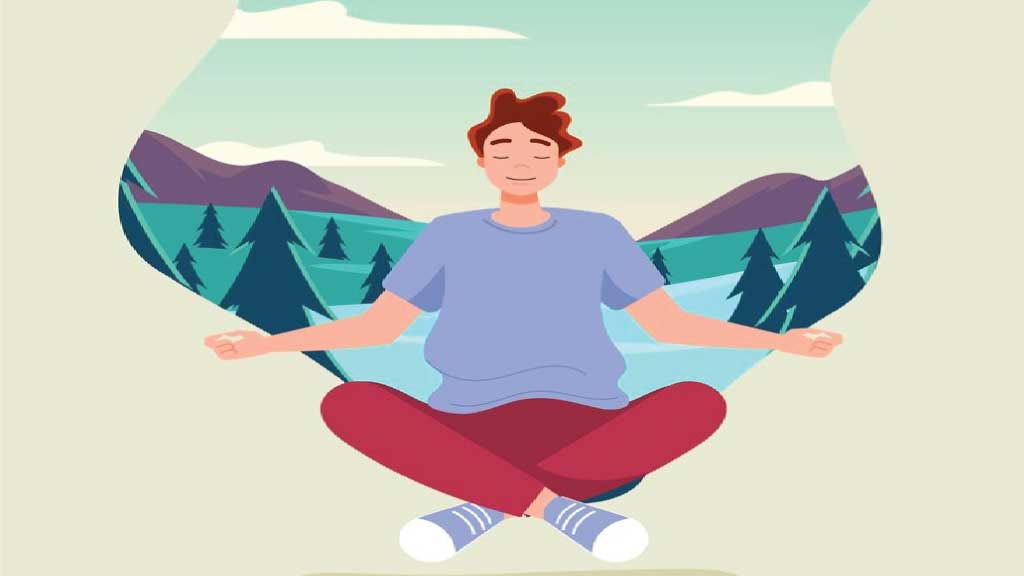Meditation for Sleep: 10 Easy Steps” offers a comprehensive guide to using meditation techniques to achieve a restful and rejuvenating night’s sleep. In today’s fast paced world, many struggle with insomnia and restless nights, leading to fatigue and diminished well being. However, with the practice of meditation, individuals can tap into their innate ability to relax the mind and body, paving the way for deep and restorative sleep.
This guide outlines ten simple yet effective steps to incorporate meditation into your bedtime routine, helping you unwind from the stresses of the day and prepare for a peaceful night of rest. From breathing exercises to visualization techniques, each step is designed to promote relaxation, alleviate stress, and cultivate a sense of inner calm conducive to falling asleep effortlessly. Say goodbye to sleepless nights and embrace the transformative power of meditation for a night of deep, restorative sleep.
Table of Contents
ToggleFind a Comfortable Position:
Finding a comfortable position is paramount for relaxation and mindfulness practices. Whether lying down on your back or sitting in a chair with your feet grounded, the physical posture sets the stage for mental tranquility.
When lying on your back, allow your body to sink into the surface beneath you, releasing any tension in your muscles. Close your eyes and focus on your breath, allowing it to flow naturally in and out of your body. With each exhale, let go of any lingering stress or thoughts that may be occupying your mind.
Alternatively, sitting in a chair with your feet flat on the floor provides a sense of stability and grounding. Keep your spine straight but not rigid, allowing for a natural curve in your lower back. Rest your hands gently on your thighs or place them in your lap, whichever feels most comfortable.
Regardless of whether you choose to lie down or sit, the key is to find a position that allows you to fully relax and be present in the moment. Pay attention to any areas of discomfort in your body and make any necessary adjustments to ensure optimal comfort.
By finding a comfortable position, you create a conducive environment for deepening your practice of mindfulness, meditation, or simply taking a moment to unwind and reset.
Relax Your Body:
Relaxing your body through progressive muscle relaxation is a powerful technique to alleviate tension and promote overall well being. Begin by finding a quiet space where you can fully focus on the process.
Start with your toes, curling them tightly for a few seconds before gradually releasing the tension. Move upward to your feet, calves, and thighs, repeating the pattern of tensing and releasing. As you progress through each muscle group, pay close attention to the sensations of relaxation washing over you.
Continue to your abdominal muscles, chest, back, and shoulders, consciously releasing any tightness or stiffness. Allow your arms, hands, and fingers to go limp as you let go of any remaining tension. Finally, focus on your neck and facial muscles, letting go of any clenched jaw or furrowed brow.
Throughout this process, synchronize your breath with the tension and release, inhaling deeply as you tense and exhaling slowly as you relax. With each repetition, feel the weight of stress melting away, leaving you feeling more at ease and rejuvenated.
By systematically relaxing each muscle group, you invite a profound sense of relaxation into your body and mind. This practice not only reduces physical tension but also cultivates a deeper awareness of the mind-body connection, fostering a state of calm and serenity.
Deep Breathing:
Deep breathing is a fundamental technique for promoting relaxation and reducing stress. By intentionally slowing down and focusing on the breath, you can activate the body’s natural relaxation response.
Begin by finding a comfortable position, whether sitting or lying down, and close your eyes if it helps you to concentrate. Inhale deeply through your nose, allowing your lungs to fill completely with air. Feel your abdomen expand as you breathe in, and hold the breath for a few moments at the top of the inhalation.
As you exhale slowly through your mouth, imagine releasing any tension or negative energy with each breath out. Pay attention to the sensation of the breath leaving your body, allowing yourself to fully relax with each exhale.
Continue this pattern of slow, deep breathing, focusing your attention solely on the rhythm of your breath. If your mind begins to wander, gently bring your focus back to the sensation of breathing in and out.
Deep breathing not only calms the mind but also oxygenates the body, promoting a sense of clarity and well being. Incorporating this practice into your daily routine can help you manage stress more effectively and cultivate a greater sense of inner peace.
Body Scan:
Body scanning is a mindfulness practice that involves systematically bringing awareness to each part of the body, from head to toe. This technique helps to cultivate a deeper connection between the mind and body, promoting relaxation and stress relief.
Begin by finding a comfortable position, either lying down or sitting with your back straight and feet flat on the floor. Close your eyes and take some deep breaths to center yourself.
Start the body scan by bringing your attention to the crown of your head. Notice any sensations, whether they are tension, warmth, or tingling. As you exhale, imagine releasing any tension or discomfort from this area.
Move your attention slowly down your body, focusing on each area in turn. Notice any areas of tightness or discomfort, and with each breath, consciously release the tension. Pay attention to your neck, shoulders, chest, arms, abdomen, hips, legs, and feet.
Continue this process of scanning and releasing tension until you have covered your entire body. Allow yourself to sink deeper into relaxation with each breath, letting go of any stress or worries that may be weighing you down.
Body scanning is a powerful tool for promoting relaxation and self awareness. By bringing attention to the body and releasing tension, you can create a sense of calm and balance in both mind and body.
Visualize Calm Scenes:
Visualizing calm scenes is a widely practiced relaxation technique that taps into the power of imagination to soothe the mind and body. By mentally transporting oneself to a serene setting, such as a tranquil beach or a lush forest, individuals can evoke feelings of peace and relaxation.
Begin by finding a comfortable position and closing your eyes to shut out external distractions. Take a few deep breaths to center yourself and then begin to imagine your chosen serene environment. Picture yourself standing on the soft sand of a deserted beach, feeling the warmth of the sun on your skin and the gentle breeze rustling through your hair. Hear the rhythmic sound of waves lapping against the shore, and smell the salty sea air.
Alternatively, envision yourself walking through a peaceful forest, surrounded by towering trees and the earthy scent of damp soil. Feel the soft moss beneath your feet and listen to the soothing sounds of birds chirping and leaves rustling in the breeze.
As you immerse yourself in these calming scenes, allow yourself to let go of any tension or stress you may be holding onto. Visualize each detail vividly, engaging all your senses to create a rich and immersive experience.
By practicing visualization regularly, you can train your mind to access feelings of calm and relaxation more easily, even in the midst of daily challenges.
Focus on Relaxing Sounds:
Focusing on relaxing sounds is a simple yet effective technique to ease the mind and promote relaxation. Whether listening to natural sounds like gentle waves or soft rainfall, or utilizing recordings specifically designed for relaxation, immersing oneself in soothing auditory experiences can induce a sense of calm and tranquility.
To begin, find a quiet and comfortable space where you can fully engage with the sounds. Close your eyes and take some deep breaths to center yourself. Then, direct your attention to the chosen sound, whether it’s the imagined crashing of waves on a beach or the pitter patter of raindrops on leaves.
Allow the sound to wash over you, focusing on its rhythm and cadence. Notice how it resonates within your body, soothing away any tension or stress. If using recordings, ensure the volume is set at a comfortable level that allows you to fully immerse yourself without causing discomfort.
As you continue to listen, let go of any distracting thoughts and simply be present with the sound. Allow it to lull you into a state of relaxation, embracing the sense of peace it brings.
By incorporating this practice into your routine, you can harness the power of sound to quiet the mind, reduce anxiety, and promote overall well being. Whether used as a standalone technique or in conjunction with other relaxation methods, focusing on relaxing sounds offers a simple yet powerful way to find inner calm in any situation.
Practice Mindfulness:
Practicing mindfulness involves intentionally bringing your attention to the present moment, without judgment or attachment. By focusing on your breath, bodily sensations, or the sounds around you, you can cultivate a greater sense of awareness and inner peace.
Begin by finding a comfortable position and taking a few deep breaths to center yourself. Close your eyes if it helps you to concentrate, and then bring your attention to your breath as it flows in and out of your body. Notice the sensation of air entering and leaving your nostrils, the rise and fall of your chest or abdomen with each inhale and exhale.
As you continue to focus on your breath, be gentle with yourself if your mind starts to wander. Simply acknowledge any thoughts or distractions that arise, and then gently guide your attention back to the present moment.
You can also practice mindfulness by tuning into the sensations in your body, noticing any areas of tension or relaxation without trying to change them. Alternatively, you can focus on the sounds around you, whether it’s the hum of traffic outside or the chirping of birds.
The key is to let go of any thoughts or worries about the past or future, and simply be fully present with whatever is happening in the here and now. By cultivating mindfulness in this way, you can experience greater clarity, peace, and overall well being in your daily life.
Use Mantras or Affirmations:
Using mantras or affirmations is a powerful technique to quiet the mind and cultivate a sense of relaxation and inner peace. By repeating a soothing phrase silently to yourself, you can shift your focus away from negative thoughts and worries, promoting a more positive and calm state of mind.
Choose a mantra or affirmation that resonates with you and reflects the state of relaxation you wish to achieve. It could be something as simple as “I am calm and relaxed,” “I am at peace,” or “I trust in the present moment.” Repeat the chosen phrase silently or softly aloud, allowing its meaning to sink in with each repetition.
As you continue to repeat the mantra, allow yourself to let go of any tension or stress you may be holding onto. Focus on the words and the feelings they evoke within you, allowing them to wash over you like a gentle wave of tranquility.
If your mind starts to wander or if negative thoughts arise, gently bring your attention back to the mantra, using it as an anchor to guide you back to a state of relaxation.
Practicing mantras or affirmations regularly can help rewire your brain to focus on positivity and promote a more peaceful mindset. Incorporate this practice into your daily routine, whether it’s during meditation, before bed, or whenever you need a moment of calm amidst the chaos of daily life.
Progressive Muscle Relaxation:
Progressive Muscle Relaxation (PMR) is a relaxation technique that involves systematically tensing and then relaxing each muscle group in the body. By deliberately inducing tension and then releasing it, PMR can help alleviate physical and mental stress, promoting a profound sense of relaxation and well-being.
To practice PMR, find a quiet and comfortable space where you can fully focus on the process. Begin by taking a few deep breaths to center yourself and then direct your attention to your toes. Curl them tightly for a few seconds, noticing the sensation of tension, before gradually releasing and allowing them to relax completely.
Move upward through your body, systematically tensing and relaxing each muscle group. Progress from your feet to your calves, thighs, abdomen, chest, arms, hands, shoulders, neck, and finally, your face and scalp.
As you engage in this process, pay close attention to the contrast between tension and relaxation in each muscle group. Notice how each release of tension brings about a deeper sense of calm and ease.
By practicing PMR regularly, you can become more attuned to the signals of tension in your body and learn to release them more effectively. This technique can be particularly beneficial for managing stress, reducing muscle tension, and promoting overall relaxation and well being.
Gratitude and Positivity:
Ending your meditation with gratitude and positivity is a wonderful way to cultivate a sense of peace and contentment before drifting off into sleep. As you close your practice, take a moment to reflect on the day and express gratitude for the experiences, opportunities, and blessings it brought.
Start by bringing to mind three things you are grateful for, whether they are big or small, significant or seemingly insignificant. It could be the support of loved ones, a moment of laughter, or simply the warmth of the sun on your face. Allow yourself to truly feel appreciation for these blessings, letting the gratitude fill your heart and mind.
Next, shift your focus to positive thoughts and feelings. Replace any lingering worries or stressors with thoughts of hope, joy, and optimism. Visualize yourself surrounded by light and positivity, radiating warmth and love.
As you immerse yourself in feelings of gratitude and positivity, allow them to envelop you like a comforting blanket, guiding you gently into a peaceful sleep. Surrender to the tranquility of the moment, knowing that you are surrounded by blessings and supported by the universe.
By ending your meditation with gratitude and positivity, you set the stage for a restful and rejuvenating night’s sleep, awakening refreshed and ready to embrace the new day ahead.
Conclusion:
In conclusion, incorporating meditation into your bedtime routine can significantly improve the quality of your sleep and overall well being. By following the ten easy steps outlined in “Meditation for Sleep: 10 Easy Steps,” you can cultivate a deeper sense of relaxation and inner peace, setting the stage for a restful night’s sleep. From focusing on your breath to visualizing calming scenes, these techniques empower you to quiet the mind, release tension, and let go of the stresses of the day.
As you make meditation a regular part of your nightly ritual, you’ll find yourself drifting off to sleep more easily and waking up feeling refreshed and rejuvenated. So, embrace the transformative power of meditation and reclaim your nights for restorative rest and relaxation. Say goodbye to sleepless nights and hello to a new dawn of peaceful slumber.
FAQs:
How can meditation help improve sleep?
Meditation promotes relaxation and reduces stress and anxiety, making it easier to fall asleep and experience deeper, more restful sleep cycles. By calming the mind and body, meditation can alleviate sleep disturbances and promote overall sleep quality.
When is the best time to meditate for sleep?
The best time to meditate for sleep is typically before bedtime. Engaging in a meditation practice in the evening can help unwind from the day’s stresses and prepare the mind and body for restful sleep.
How long should I meditate for sleep each night?
Aim for at least 10-20 minutes of meditation before bedtime to reap the sleep inducing benefits. However, even a short meditation session can be effective in promoting relaxation and improving sleep quality.
Are there specific meditation techniques that are best for sleep?
Yes, techniques such as deep breathing, body scanning, and visualization are particularly effective for promoting relaxation and preparing the body for sleep. These practices help calm the mind, release tension, and create a conducive environment for restful sleep.
Can meditation for sleep be practiced in bed?
While it’s possible to practice meditation for sleep in bed, it’s generally recommended to find a comfortable spot outside of the bedroom to avoid associating your bed with wakefulness. However, if practicing in bed works best for you, focus on maintaining good posture and avoiding distractions to maximize its effectiveness.
All Images ‘Designed by Freepik‘





